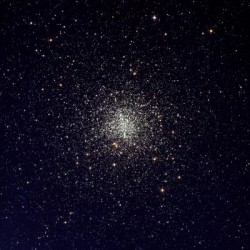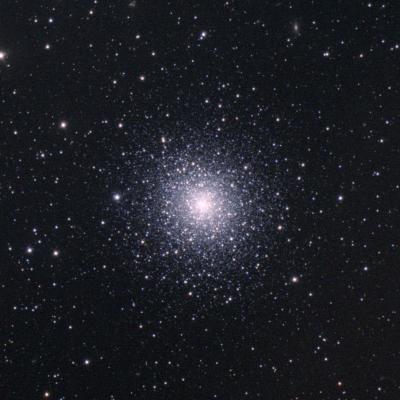[/caption]Greetings, fellow SkyWatchers! Now that the Moon is gone from the early evening skies and I’m back from that soul vacation, tracing my way across the constellations it’s time to break out binoculars and telescopes and enjoy some of the summer’s finest globular clusters – both easy and challenging. For everyone, it’s also time to get back in our atmosphere with drops of Jupiter in our hair and check out the Mighty Jove as it smokes up the sky. Are you ready to dance?
Friday, July 25 – Today in 1971, Apollo 15 was launched on its way to the Moon, and tonight we’ll launch our way north to the Mighty Hercules for a look at another globular study – M92. Although in a relatively open field for starhoppers, it’s not too hard to find if you can imagine it as the apex of a triangle with the northern keystone stars – Eta and Pi – as the base (RA 17 17 07 Dec +43 08 11).
At near magnitude 6, Class IV M92 was discovered by Johann Bode in 1777 and cataloged as Bode 76. Independently recovered by Messier in 1781 and resolved by Herschel in 1783, this bright, compact globular is around 26,700 light-years away and is about 12 to 14 billion years old. It contains 14 RR Lyrae variables among its 330,000 stars and also a very rare eclipsing binary. Viewable unaided under the right conditions and very impressive in even small binoculars, M92 is a true delight to even the smallest of telescopes. It has a very bright and unresolvable core with many outlying stars that are easily revealed. Larger scopes will appreciate its fiery appearance!
Now let’s hop south to Beta Ophiuchi to have a look at NGC 6426 about a fingerwidth south (RA 17 44 54 Dec +-3 10 12). There’s a very good reason why you’ll want to at least try with Herschel II.587. Discovered by Sir William in 1786, this 11th magnitude Class IX globular looks destroyed in comparison to M92. At 67,500 light-years away, it is more than twice the distance from us as M92! Residing 47,600 light-years from the galactic center, NGC 6426 contains 15 RR Lyrae variables (three of which are newly-discovered), and is the most metal-poor globular known. So what’s the relation to M92? It’s even a little bit older!
Forget about finding this one in binoculars and very small telescopes. For the mid-sized scope you’ll find it conveniently located about halfway between Beta and Gamma Ophiuchi – but it’s not easy. Faint and diffuse, a large telescope is required to begin resolution.
Saturday, July 26– For hardcore observers, tonight’s globular cluster study will require at least a mid-aperture telescope, because we’re staying up a bit later to go for a pair that can be seen in the same low power field – NGC 6522 and NGC 6528. You will find them easily at low power just a breath northwest of Gamma Sagittarii (Al Nasl), or the tip of the “teapot’s” spout. Once located, switch to higher power to keep the light of Gamma out of the field and let’s do some studying.
The brighter, and slightly larger, of the pair to the northeast is Class VI NGC 6522 (RA 18 03 34 Dec 30 02 02). Note its level of concentration compared to Class V NGC 6528 (RA 18 04 49 Dec 30 03 20). Both are located around 2,000 light-years from the galactic center, and are seen through a very special area of the sky known as “Baade’s Window” – one of the few areas toward our galaxy’s core region not obscured by dark dust. While they are similar in concentration, distance, etc., NGC 6522 has a slight amount of resolution toward its edges while NGC 6528 appears more random.
Both NGC 6522 and NGC 6528 were discovered by Sir William Herschel on the same night 1784 and both are the same distance from the galaxy’s nucleus. But there the similarities end: NGC 6522 has an intermediate metallicity. At its core, the red giants have been depleted – stripped tidally by evolving blue stragglers. It is possible that core collapse has already occurred. NGC 6528, however, contains one of the highest metal contents of any known globular cluster collected in its bulging core!
 Now, let’s go kill our night vision and have a look at Jupiter! During the course of the evening of July 26-27, several events will happen – including eclipses and transits. For viewers in the United States eastern time zone, look for the Great Red Spot to appear on the meridian at around 10:48 p.m. While it’s difficult to make out the faint contrast of this most popular of all jovian features, take the opportunity to experiment with color filters if you have them. Even wearing sunglasses can sometimes produce surprising results!
Now, let’s go kill our night vision and have a look at Jupiter! During the course of the evening of July 26-27, several events will happen – including eclipses and transits. For viewers in the United States eastern time zone, look for the Great Red Spot to appear on the meridian at around 10:48 p.m. While it’s difficult to make out the faint contrast of this most popular of all jovian features, take the opportunity to experiment with color filters if you have them. Even wearing sunglasses can sometimes produce surprising results!
 Sunday, July 27 – Today in 1892, a very special astronomer was born – Sir George Biddell Airy. Does that name sound familiar? Anyone who uses a refractor understands the properties of the “Airy disc” as first outlined in his paper “On the Diffraction of an Object-Glass with Circular Aperture.” But, Sir George achieved a bit more: As Astronomer Royal from 1835 to 1881, his tireless devotion to planetary study led to the discovery by P. A. Hansen of two new irregularities in the moon’s motion. Not enough? Airy’s calculations also determined the mean density of the Earth. More? Then thank Sir George for giving us Greenwich Mean Time!
Sunday, July 27 – Today in 1892, a very special astronomer was born – Sir George Biddell Airy. Does that name sound familiar? Anyone who uses a refractor understands the properties of the “Airy disc” as first outlined in his paper “On the Diffraction of an Object-Glass with Circular Aperture.” But, Sir George achieved a bit more: As Astronomer Royal from 1835 to 1881, his tireless devotion to planetary study led to the discovery by P. A. Hansen of two new irregularities in the moon’s motion. Not enough? Airy’s calculations also determined the mean density of the Earth. More? Then thank Sir George for giving us Greenwich Mean Time!
Are you still having no luck in finding a deep-space object? Then how about one that’s simple to locate for all optics. All you have to know is Antares and go west…

As one of the loosest globular clusters, M4 would be tremendous if we were not looking at it through a heavy cloud of interstellar dust. To binoculars, it is easy to pick out a very round, diffuse patch – yet it will begin resolution with even a small telescope. Large telescopes will also easily see a central “bar” of stellar concentration across M4’s core region, which was first noted by Herschel.
As an object of scientific study, the first millisecond pulsar was discovered within M4 in 1987 – one which spins 10 times faster than the Crab Nebula pulsar. Photographed by the Hubble Space Telescope in 1995, M4 was found to contain white dwarf stars – the oldest in our galaxy – with a planet orbiting one of them! A little more than twice the size of Jupiter, this planet is believed to be as old as the cluster itself. At 13 billion years, it would be three times the age of the Sol system!
Have a great weekend….


Isn’t M4 EAST and south of antares and not WEST?
At least my eyes last week and stellarium tells me that.
(pssst…. no offense, but you better look again.)
They are right it is west. Since when you look at it your facing south so since its to the right which is west.
Now if you were facing North then it would be east.
psssstttt…. Its west of Antares, its west whether you face south or north or stand on your head.